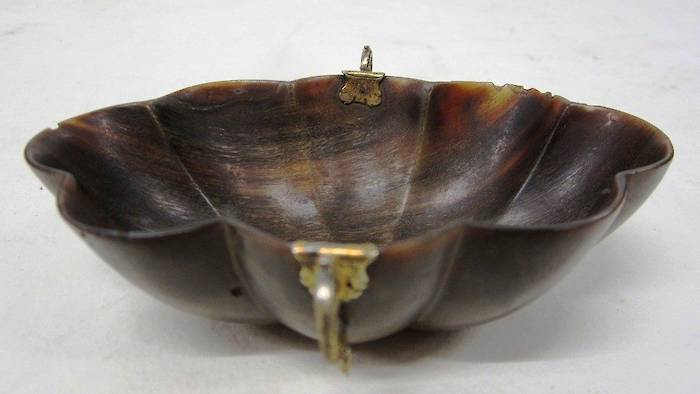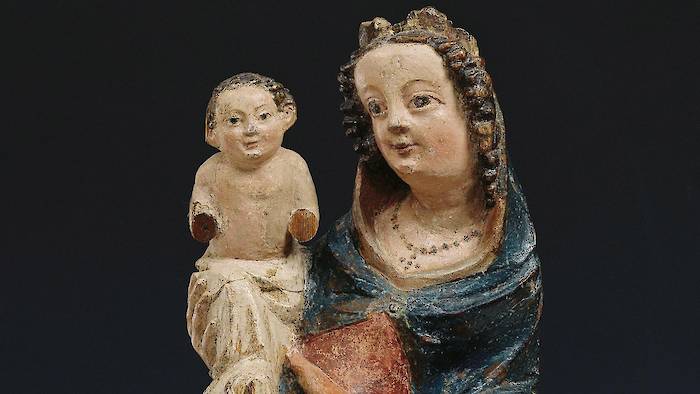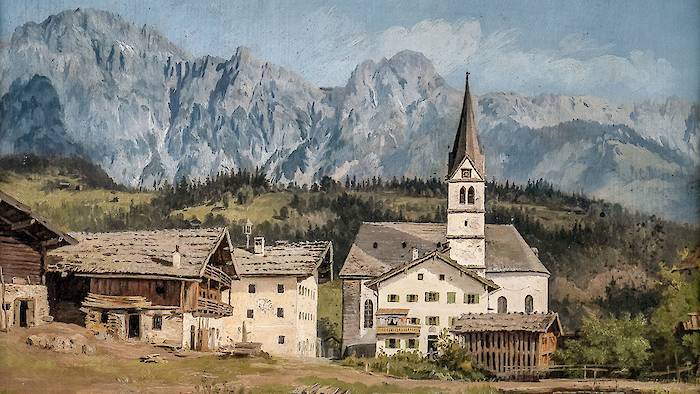A selection of our current exhibits
- ibex horn bowlArt in a natural material
 ibex horn bowlArt in a natural material
ibex horn bowlArt in a natural materialThe horn of the alpine ibex was processed from the second half of the 17th century on. The material was said to have healing properties. Local craftsmen not only created objects for daily use, such as the ibex bowl at the Mining and Gothic Museum, but, among other items, rings for people suffering from gout.
However, the mass processing of horn led to the drastic decline of the eastern alpine ibex at the beginning of the 18th century. In the Zillertal valley for instance, the last mention of ibexes in a written document was in 1706.
It was not until the mid-18th century that the number of ibexes in Salzburg’s mountains started to rise again. In documents from same time we find evidence of horn carvers, such as Lorentz Härmler - the “ibex horn carver of the meadows” - or the sculptors Leopold Ehegasser and Joseph Glarer, being based in Salzburg.
- Lion MadonnaRare masterpiece
 Lion MadonnaRare masterpiece
Lion MadonnaRare masterpieceMadonnas standing or enthroned upon a lion are very rare. The first of these sculptures probably date back to the early period of Emperor Charles IV in the first half of the 14th century.
The sculpture on display at the Leogang Mining and Gothic Museum is one of an exclusive circle of Salzburg Lion Madonnas, to which only six others in the world belong. One is in Bachschmiede in Wals near Salzburg, two are at the Bavarian National Museum in Munich, one is in private ownership in Hamburg, one is in Berlin’s Bode Museum and the sixth can be found at the Louvre in Paris.
The Lion Madonna at the Leogang Mining and Gothic Museum was created around 1370 in pine wood. The description of the Lion Madonna is basically consistent with the older Lion Madonna in the Bavarian National Museum. With her crown and the now-missing sceptre in her left hand, she represented the Queen of Heaven. The falling veil, which seems to be buttoned over her chest, only covers the crown of her head, the curls on either side of her face remaining exposed.
An archaic smile lightens up her face and that of the Infant Jesus. She stands in a distinctive S-pose. The Infant Jesus, wrapped in swaddling, sits facing front on his mother’s right arm.
The lion is cowering on the low base plate. His jaw is open without baring his teeth and he has a thick, stylised mane and his tail between his legs. Originally the Infant Jesus, whose arms have survived as mere stumps, was presumably touching his right ear, demonstrating that he is listening to the roar of the lion beneath him, the symbol of the resurrection.
Mary is standing with both feet on the lion. The central part of the drapery or arrangement of the folds of her mantle is dominated by descending concentric circles.
The blue mantle of the Mother of God ends at approximately knee height, under which a more snug red robe is visible, hanging down towards the lion’s body.
- Painting of Old LeogangChurch and Kirchenwirt
 Painting of Old LeogangChurch and Kirchenwirt
Painting of Old LeogangChurch and KirchenwirtThe oil painting Alt Leogang by Michael Hofer has special significance for the region, as images of the municipality of Leogang in the mid-19th century are extremely rare.
If you view the centre of Leogang from the south, hardly anything has changed since Michael Hofer’s day. As then, the parish church of St. Leonhard and the historic ‘Kirchenwirt’ with its listed stable and farm buildings characterise Leogang in all its picturesque uniqueness.
It is assumed that the current parish church is at least the fourth sacred building to stand on this spot. The original patron saint of the church was St. Giles, but since 1477 it appears to have been St. Leonard, the so-called ‘God of Bavarian’.
St. Leonhard’s Church is unique because of the mighty iron chain around it. This rare motif is only found in churches dedicated to St. Leonhard, the ‘chain saint’. The people say ‘Mit seiner großen Ketten tut Leanhascht Leut und Vieh erretten’. (‘Leonhard will save the people and livestock with his chains.’)
St. Leonhard is pictured with a chain, as he strives to liberate prisoners. Since the 11th century he has been regarded as the patron saint of livestock, particular of horses. Incidentally, St. Leonhard’s Church is the only one of its kind in the archdiocese of Salzburg.
Behind the buildings on Hofer’s oil-on-cardboard painting is the picturesque backdrop of the Leogang Mountains, or ‘Pinzgau Dolomites’. The painting belongs to the Leogang Mining and Gothic Museum and bears Hofer’s handwritten title with his birth and death dates.
Our Museum Audio Guide
Interested in our exhibits?
Our free media guide provides fascinating information.
Have a look: Audio-Guide
